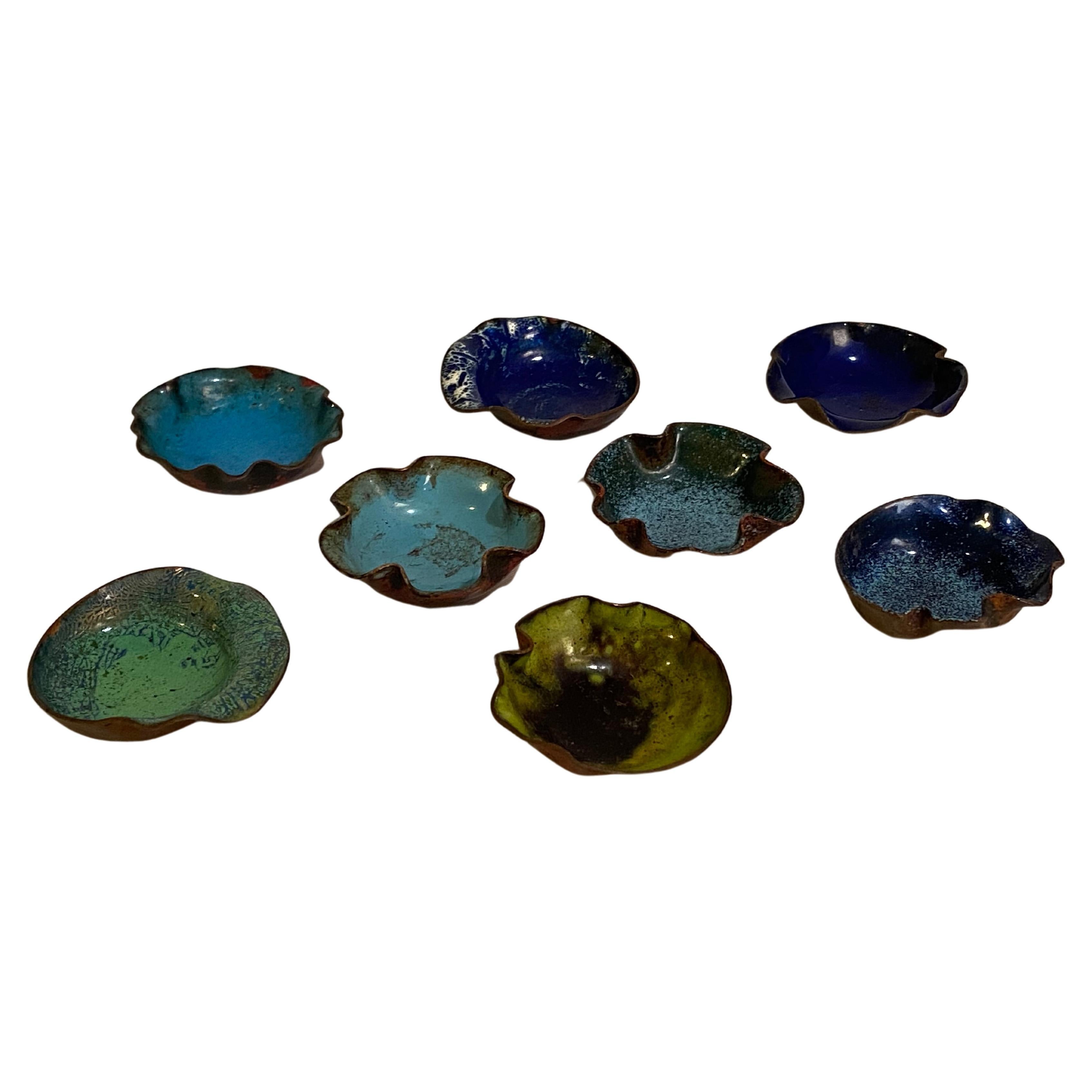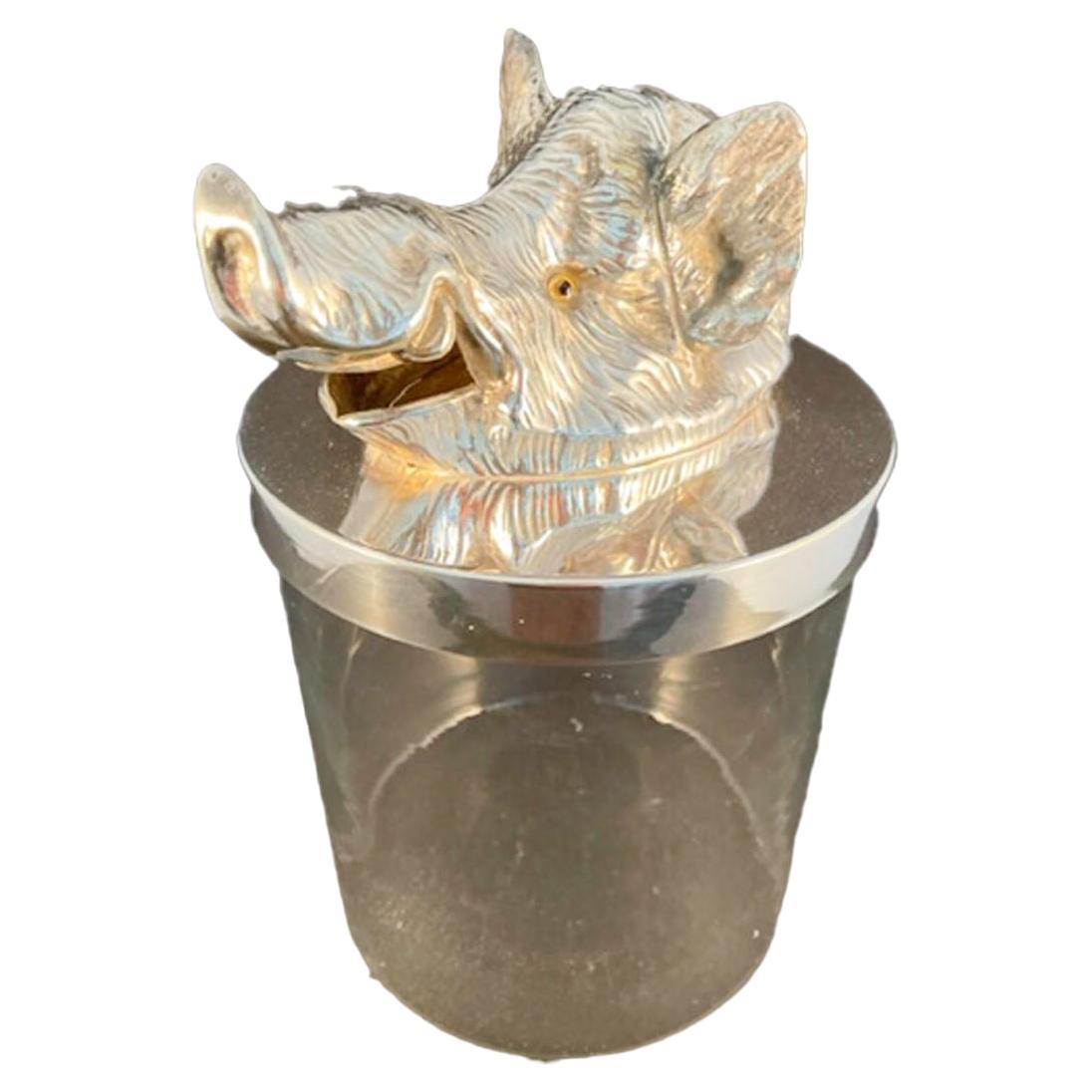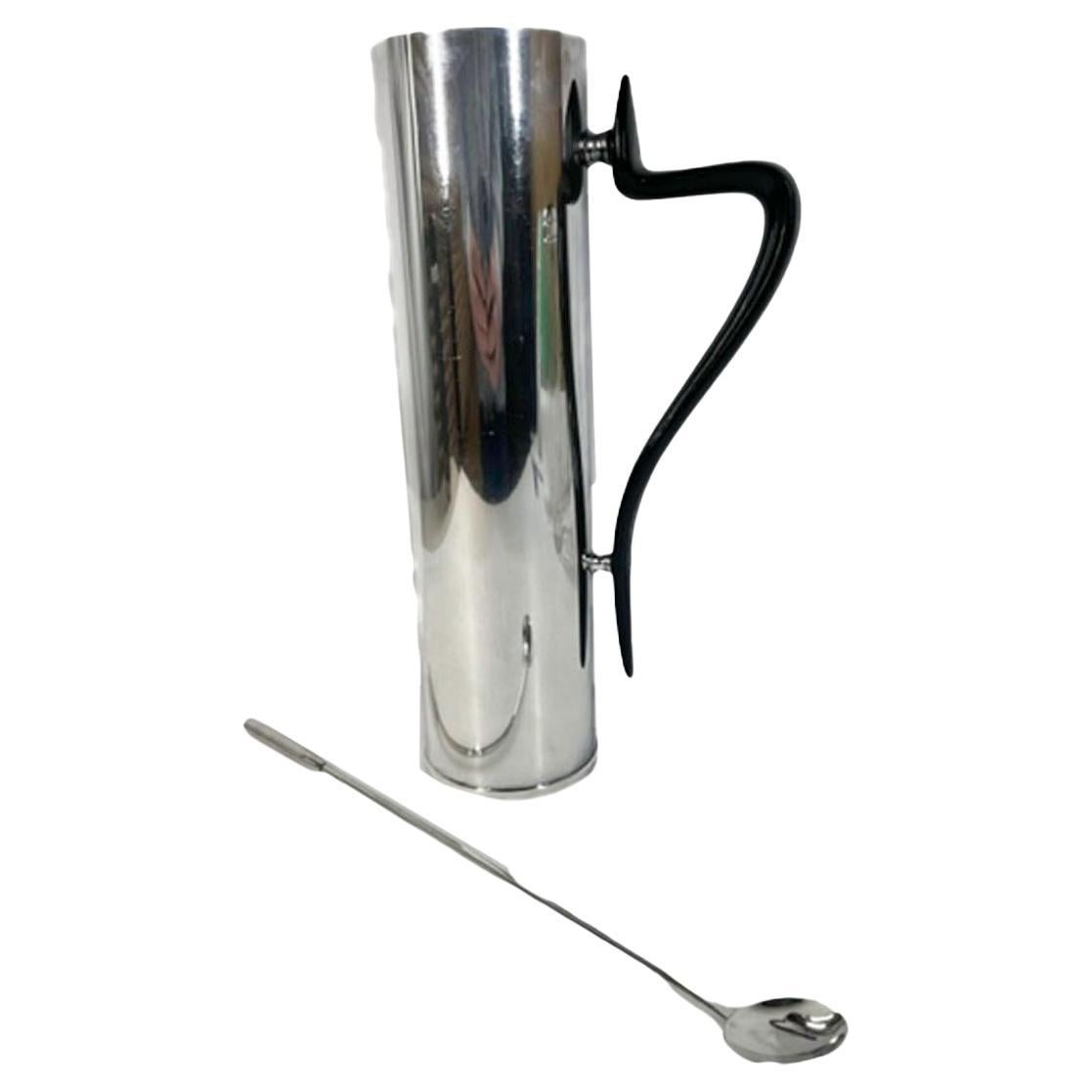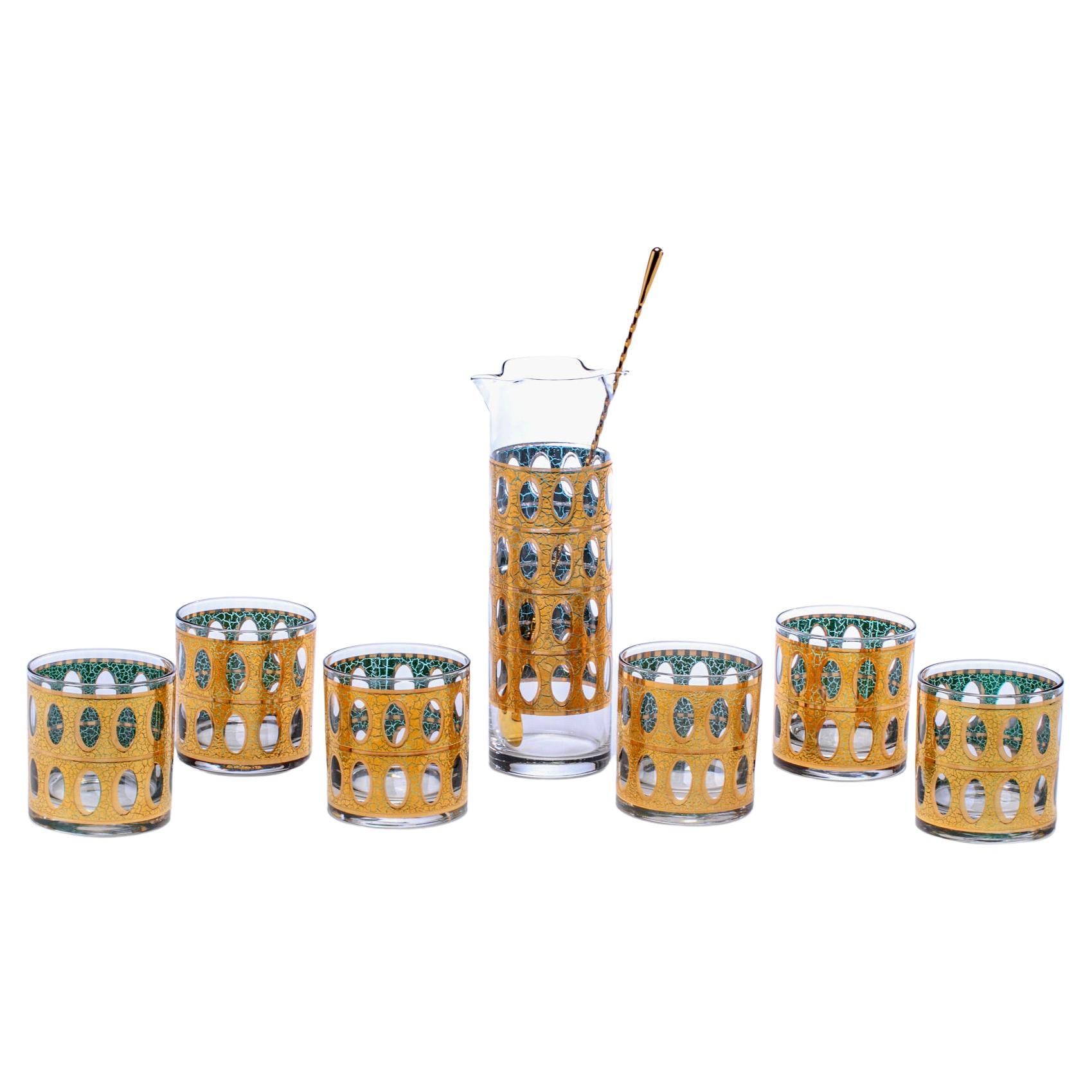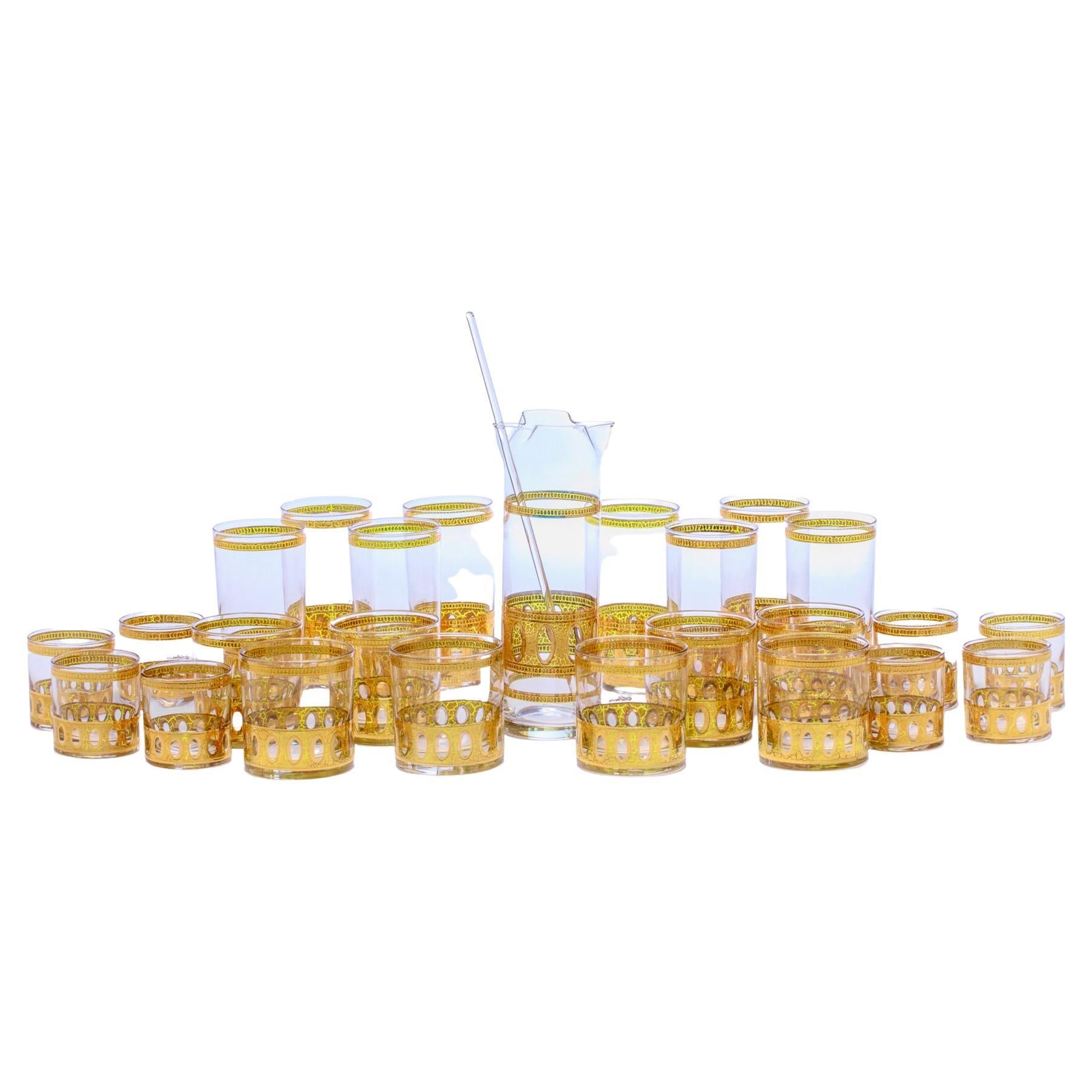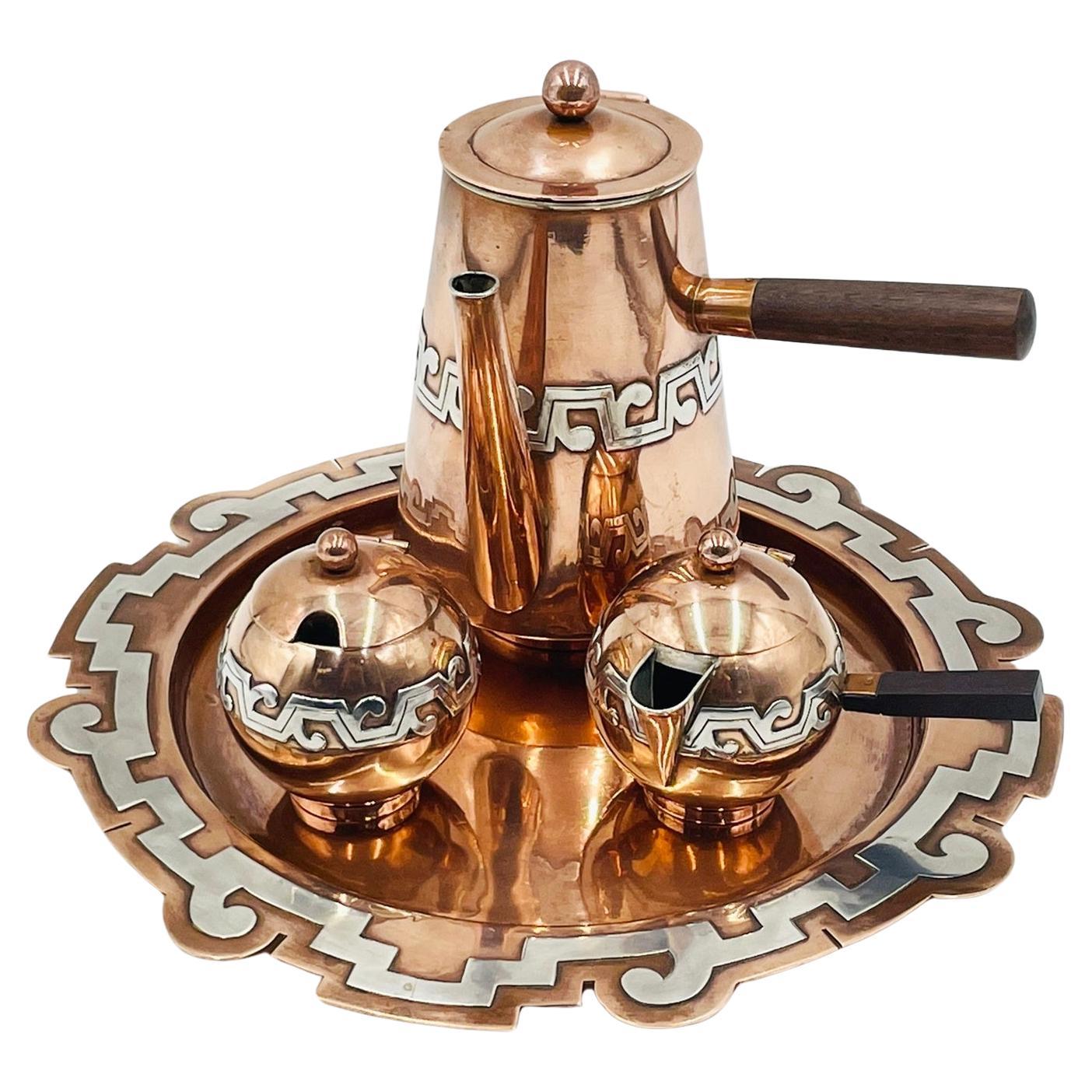Items Similar to Mexican Mid-Century Modern Victoria De Taxco Copper and Silver Plate Coffee Set
Want more images or videos?
Request additional images or videos from the seller
1 of 7
Mexican Mid-Century Modern Victoria De Taxco Copper and Silver Plate Coffee Set
About the Item
An early 1950's Taxco, Mexico copper and silver plate coffee set by Ana María Núñez de Brilanti, "Victoria de Taxco" The set is composed by a coffee kettle, a creamer, a sugar bowl and a tray. The kettle, the creamer and the tray have carved wood handles; the bowl includes a spoon. Serving pieces show a silver trim of Prehispanic inspired design.
All pieces are sealed underneath; the spoon also shows the "Cony" retailer shop mark. The kettle shows important dents on body and base.
Dimensions:
Coffee kettle: 21 x 22 x 15 cm. (8.25 x 8.75 x 6 inches).
Creamer: 12 x 13.5 x 8 cm. (4.75 x 5.25 x 3.13 inches).
Sugar bowl: 12 x 8.5 cm. Ø (4.75 x 3.63 inches).
Tray: 51 x 29.5 x 3 cm. (20 x 11.63 x 1.25 inches).
Ana María Núñez was born on December 21th, 1907. The eldest daughter of a Revolution-era colonel, she lived in downtown Mexico City during her youth. She learned languages, piano and worked as general assistant to Diego Rivera during the latest's muralist work in Palacio Nacional.
In 1931 she married Rafael Brilanti, a public servant; in 1939, the family moved to Taxco, where his husband was sent to work. She later met William Spratling, who cheered her to work as a silversmith. By 1948, she founded her Victoria workshop along the ones by Antonio Castillo and Margot van Voorhies.
As most metal workers of her generation, her jewelry and utilitarian pieces explored the prehispanic iconography and motiffs. However, she also used other picturesque scenes and characters such as waterboys, pack donkeys, peasants and bullfighters.
- Creator:Victoria of Taxco (Metalworker)
- Dimensions:Height: 9.45 in (24 cm)Width: 19.69 in (50 cm)Depth: 11.62 in (29.5 cm)
- Sold As:Set of 4
- Style:Mid-Century Modern (Of the Period)
- Materials and Techniques:
- Place of Origin:
- Period:
- Date of Manufacture:circa 1950
- Condition:Wear consistent with age and use. Minor structural damages.
- Seller Location:Mexico City, MX
- Reference Number:1stDibs: LU3125330416602
About the Seller
4.0
Vetted Seller
These experienced sellers undergo a comprehensive evaluation by our team of in-house experts.
Established in 2005
1stDibs seller since 2017
36 sales on 1stDibs
Typical response time: 1 hour
- ShippingRetrieving quote...Ships From: Mexico City, Mexico
- Return PolicyA return for this item may be initiated within 3 days of delivery.
More From This SellerView All
- Mexican Mid-Century Modern Embossed Copper Jewel BoxLocated in Mexico City, MXA nice Mexican Mid-Century Modern copper sheet jewel box in shape of a chest. The embossed designs show acanthus leaves and a rosette. The jewel box's interior and removable tray ...Category
Vintage 1960s Mexican Mid-Century Modern Jewelry Boxes
MaterialsCopper
- Fred Davis Mexican Taxco Sterling Silver and Green Jasper ChokerBy Fred DavisLocated in Mexico City, MXA 1950's Sterling silver choker with prehispanic design by American designer Frederick "Fred" Davis. Manufactured in Taxco, Guerrero. The choker's links show a prehispanic Mayan glyp...Category
Vintage 1950s Mexican Mid-Century Modern Collectible Jewelry
MaterialsSterling Silver
- Mexican Mid-Century Modern Steel ScreenLocated in Mexico City, MXInteresting 1970s Mexican Mid-Century Modern steel screen. The organic design can be used as the frame for a stained glass window.Category
Vintage 1970s Mexican Mid-Century Modern Windows
MaterialsSteel
- Arturo Pani Mexican Mid-Century Modern Pair of Iron ObelisksBy Arturo PaniLocated in Mexico City, MXPair of Mexican Mid-Century Modern iron obelisks. The obelisks show green patina.Category
Vintage 1960s Mexican Mid-Century Modern Obelisks
MaterialsIron
- Gail Reed Mid-Century Modern Ceramic SculptureLocated in Mexico City, MXMid-Century Modern ceramic sculpture by Canadian potter Gail Reed. The organic punched design shows a green and yellow finish. Signed on the bottom. Gail ...Category
Vintage 1970s Canadian Mid-Century Modern Abstract Sculptures
MaterialsPottery
- Cristalleries Schneider Mid-Century Modern Crystal Table ClockBy Schneider GlassLocated in Mexico City, MXStunning midcentury crystal table clock by Cristalleries Schneider. Biomorphic shape crystal, round dial with golden brass edge, Roman numbers ...Category
Vintage 1960s French Mid-Century Modern Table Clocks and Desk Clocks
MaterialsCrystal, Brass
You May Also Like
- Mid Century Modern Biomorphic Enamel on Copper Salts, Set of EightBy BovanoLocated in Garnerville, NYSet of eight fine Mid Century Modern biomorphic enamel on copper salts. Very distinct set of crimped and crinkled enameled salts. Circa 1965. Enameling became a huge crafts movement ...Category
Vintage 1960s American American Craftsman Serving Pieces
MaterialsCopper, Enamel
- Mid-Century Boar Head, Glass and Silver Plate Ice BucketLocated in Nantucket, MAVintage clear glass jar of cylindrical form with a silver plate rim and lid. The lid with a model of a Boar's head with glass eyes. Attributed ...Category
Mid-20th Century Spanish Mid-Century Modern Barware
MaterialsSilver Plate
- Mid-Century Modern Silver-Plate Cocktail Pitcher by Gorham, D.H. Colflesh DesignBy Donald Colflesh, GorhamLocated in Nantucket, MASilver plate cocktail pitcher (with associated stir spoon) designed in 1959 by Donald H. Colflesh for Gorham. This design was included in the 2006 Smithsonian Institute exhibit "Mode...Category
Mid-20th Century American Mid-Century Modern Barware
MaterialsSilver Plate
- Mid-Century Modern Culver Gold Plated Cocktail Mixer & Rocks Glasses Set c. 1965By Culver Ltd.Located in Saint Louis, MOSexy Mid-Century Modern cocktail mixer and matching rocks glasses set with 22k gold plating produced by Culver in the late 1960s. This set is in grea...Category
Vintage 1960s American Mid-Century Modern Barware
MaterialsGold Plate
- Mid-Century Modern Gold Plated Barware Set of Glasses & Mixer by Culver c. 1965By Culver Ltd.Located in Saint Louis, MOLarge and complete 22k gold plated Mid-Century Modern barware set by Culver that's in great condition and free from any defects or gold wear. This set is really exquisite as if transported in time from 1965. Our shop collected this pattern over several years, purging damaged or worn pieces and keeping only the best. Voilà! We've done all the work for you - now it's yours to enjoy. Makes a most impressive gift for a friend or loved one. So chic, your cocktails have never looked better. The set has you covered for a fashionable and stylish cocktail party and includes 8 Whisky glasses, 8 Rocks glasses, 8 Highball cocktail glasses and a Cocktail Mixer with original glass stirrer...Category
Vintage 1960s American Mid-Century Modern Barware
MaterialsGold Plate
- Coffee Service by Ana Maria Nunez De Brilanti for Plateria Victoria, Mexico 1960By Victoria of TaxcoLocated in Los Angeles, CAIntroducing the remarkable Copper & Silver Coffee/Tea Service by Ana Maria Nunez De Brilanti for Plateria Victoria, Mexico 1960's. Immerse yourself in the rich heritage of Mexican cr...Category
Vintage 1960s Mexican Mid-Century Modern Tea Sets
MaterialsSilver Plate, Copper
Recently Viewed
View AllMore Ways To Browse
Vintage Coffee Set
Retro Coffee Sets
Copper On Silver
Silver Vintage Shop
The Vintage Silver Shop
6 Inch Plates
Midcentury Modern Silver Jewelry
Vintage Inspired Plates
Victoria Jewelry
Mexico Taxco
Mexican Taxco
Used Victoria Jewellery
Used Victoria Jewelry
Silvered Copper Plates
Silver Plated Copper
Plate 22 Cm
Taxco Mexico Silver
Mexican Silver Taxco
